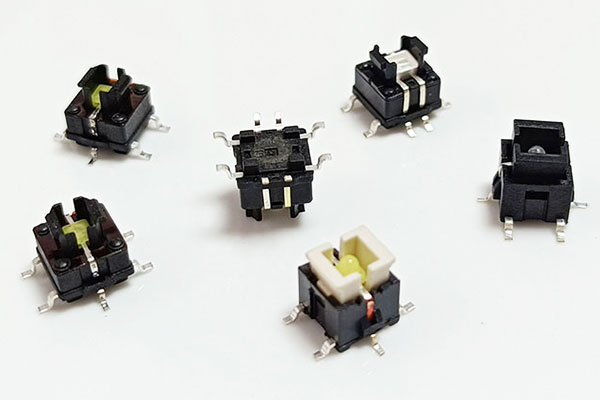Knowledge
How does an illuminated switch work?
Illuminated switches, also known as lighted switches or illuminated push buttons, are electromechanical devices that incorporate an LED (Light Emitting Diode) or other light source to provide visual indication of the switch's status. These switches are commonly used in various electronic devices and control panels where clear visual feedback is required, such as in automotive dashboards, industrial control panels, and consumer electronics. In this comprehensive explanation, we'll explore the working principles, components, types, applications, and advantages of illuminated switches.

1. Working Principle of Illuminated Switches:
a. LED Integration:
Illuminated switches typically incorporate an LED within the switch housing or behind the actuator.
When the switch is in the ON position or activated, the LED lights up, emitting light through the actuator or a transparent portion of the switch housing.
b. Electrical Circuit:
The LED is connected to an electrical circuit that includes the switch contacts.
When the switch is pressed or toggled, the electrical contacts close, completing the circuit and allowing current to flow through the LED.
c. Visual Indication:
The illuminated LED provides visual indication of the switch's status, making it easy for users to identify whether the switch is ON or OFF.
This visual feedback enhances user interaction and ensures proper operation of the device or equipment.
2. Components of Illuminated Switches:
a. Actuator:
The actuator is the part of the switch that users interact with to activate or deactivate the switch.
It can be a button, rocker, toggle, or other mechanism depending on the switch type and application.
b. LED:
The LED serves as the light source in illuminated switches.
It may be a standard single-color LED or a multi-color RGB (Red-Green-Blue) LED, offering versatility in illumination options.
c. Switch Contacts:
The switch contacts are responsible for making or breaking the electrical connection when the switch is activated.
They consist of conductive metal components that come into contact with each other to complete the circuit.
d. Housing:
The housing of the switch encloses and protects the internal components.
It may be made of plastic, metal, or other materials and is designed to withstand mechanical stress and environmental conditions.
3. Types of Illuminated Switches:
a. Push Button/Tact Switch:
Push button illuminated switches feature a button actuator that users press to activate the switch.
They are commonly used in control panels, appliances, and automotive applications.
b. Rocker:
Rocker illuminated switches have a rocker-style actuator that users toggle up and down to turn the switch ON or OFF.
They are often found in household lighting controls and dashboard panels.
c. Toggle:
Toggle illuminated switches have a lever-style actuator that users flip or toggle to switch between ON and OFF states.
They are used in various applications, including industrial controls and electronic equipment.
d. Rotary:
Rotary illuminated switches feature a rotary knob or dial that users turn to select different modes or settings.
They are commonly used in audio equipment, instrumentation, and HVAC controls.
4. Applications of Illuminated Switches:
a. Automotive:
Illuminated switches are widely used in automotive applications for dashboard controls, interior lighting, and accessory switches.
They provide clear visual indication of switch status, enhancing safety and convenience for drivers.
b. Industrial:
In industrial settings, illuminated switches are employed in control panels, machinery, and equipment for process control and automation.
Their robust construction and visual feedback make them suitable for harsh industrial environments.
c. Consumer Electronics:
Illuminated switches are integral components of consumer electronic devices such as audio systems, gaming consoles, and home appliances.
They contribute to the aesthetic appeal and user-friendly interface of these products.
d. Medical Equipment:
In medical equipment and devices, illuminated switches are used for user interface controls, patient monitoring systems, and diagnostic instruments.
Their reliable performance and visual indication ensure accurate operation in critical healthcare environments.
5. Advantages of Illuminated Switches:
a. Enhanced Visibility:
The illumination provided by the LED ensures clear visibility of switch status, even in low-light conditions.
Users can easily identify the ON or OFF position of the switch, reducing the risk of errors or confusion.
b. Improved Aesthetics:
Illuminated switches add a stylish and modern touch to electronic devices and control panels.
They enhance the overall appearance of the equipment and contribute to a sleek and professional design.
c. User-Friendly Interface:
The visual feedback provided by illuminated switches improves user interaction and usability.
Users can quickly and intuitively operate the switches, enhancing their overall experience with the device or equipment.
d. Safety and Convenience:
Illuminated switches improve safety by providing clear indication of switch status, particularly in emergency or critical applications.
They offer added convenience by allowing users to locate and operate switches easily, even in dimly lit environments.
Conclusion:
In conclusion, illuminated switches play a crucial role in various electronic devices and control systems, offering visual indication of switch status and enhancing user interaction. Their integration of LEDs provides clear visibility, improved aesthetics, and added functionality, making them indispensable components in automotive, industrial, consumer electronics, and medical applications. By understanding the working principles, components, types, applications, and advantages of illuminated switches, designers and engineers can effectively incorporate them into their designs to create user-friendly and visually appealing products.
RELATED NEWS
- Can a metal button switch be integrated with indicator lights 2025-12-08
- The difference between a momentary and a latching metal button switch 2025-12-08
- What size is the broadcasting illuminated push button 2025-12-03
- Video illuminated push button 2025-12-03
- Are DIP switches still widely used nowadays 2025-11-03
CATEGORIES
LATEST NEWS
CONTACT US
Contact: Bella
Phone: 15999819066
E-mail: rucoe@rucoe.com
Whatsapp:+86-15999819066
Add: Taoyuan Street, Nanshan, Shenzhen
